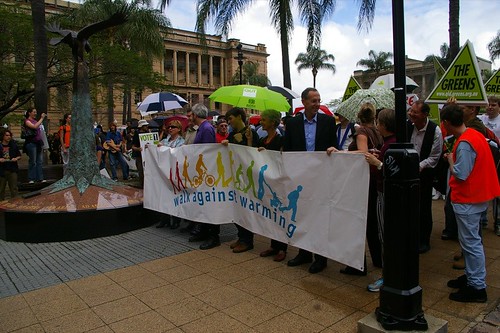February 11, 2007
From News.com.
HEATWAVES that kill thousands, gigantic bushfires and regular 100-year storms are part of a frightening new climate change forecast for Australia.
A leaked CSIRO report into the impact of global warming predicts a century of climatic horrors for the nation.
The doomsday scenario will form the basis of the Australian chapter in the Intergovernmental Panel on Climate Change report, the Federal Government's key stocktake on global warming due for release in April.
The United Nations' IPCC reports into climate change represent the world's most up-to-date assessment of how rising global temperatures will change our planet.
The CSIRO report found that extreme fire days will be more common across Australia.
The report predicts Tasmania and Victoria's east coast will be battered with massive 100-year storms, adding to beach erosion and the destruction of coastal properties.
Eucalypt forests will start to disappear, along with the delicate habitat necessary to sustain Australia's native animals.
Human lives in bigger cities will come under increasing threat, with the annual death toll from heatwaves expected to reach 1300.
And refugees from Pacific Islands submerged by water will flock into the country.
Without solid rain, Australia's crops will be affected, despite the higher temperatures helping increase the yield.
The latest Intergovernmental Panel on Climate Change has forecast a rise in average global temperatures of between 1.1 per cent and 6.4 per cent by 2100.
The CSIRO report looked at the impact of a range of temperatures, from a small decline to a rise of more than 5 per cent.
It examined the impact of rising temperatures in five key areas: ecosystems; crops, forestry and livestock; water resources; public health; and human life.
A senior CSIRO scientist said: "For the higher levels of warming, it's pretty serious for Australia."
The CSIRO paper - based also on input from universities and private groups - is the Federal Government's most authoritative report into the local impact of climate change.
The report's findings were yesterday backed by predictions of worse droughts, bushfires, floods and less marine life for Tasmania.
At a Global Warming and Politics seminar in Hobart yesterday, scientific experts and politicians agreed the clock is ticking.
"Climate change is real, its effects are happening now in many forms," visiting expert Stuart Rosewarne, senior lecturer in economics at Sydney University, said yesterday.
Dr Rosewarne said many effects were already having an impact on Tasmania and yesterday's seminar heard the more populated areas and major agricultural and farming regions would be hardest hit.
"The drought that is being experienced in Tasmania at the moment is very much shaped by global warming," he said.
"The impact will vary across Tasmania significantly with agricultural areas to be hit the hardest.
"With declined rainfall and increased temperatures, some of the forests will be badly affected.
"Some of the plantations that are being developed at the moment are not growing as fast as anticipated which is directly related to climate change and rainfall patterns."
Dr Rosewarne said rainfall was expected to decrease 10 per cent in summer but in some areas it could fall a further 20 to 30 per cent.
"There has been a fairly significant decline in rainfall patterns in some areas of Tasmania in the past five years," he said. "Predictions indicate this will only get worse."
Read the article.
Sunday, February 11, 2007
Grim toll in doomsday forecast
Posted by
National Enquirer
at
10:22 am
![]()
Labels: australia, climate change, csiro, drought, intergovernmental panel on climate change, ipcc
Subscribe to:
Post Comments (Atom)





No comments:
Post a Comment